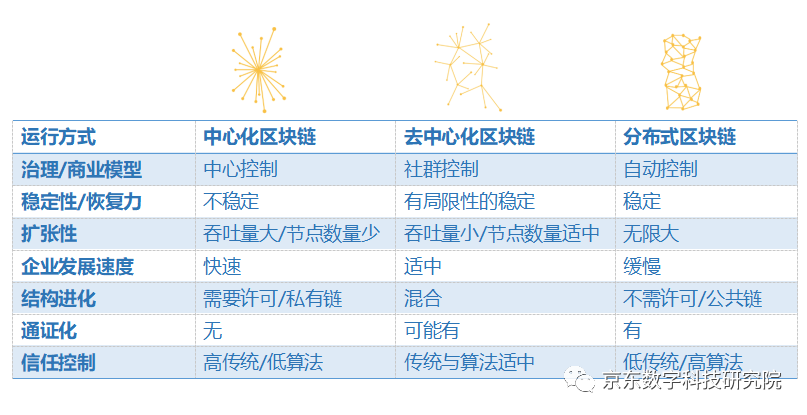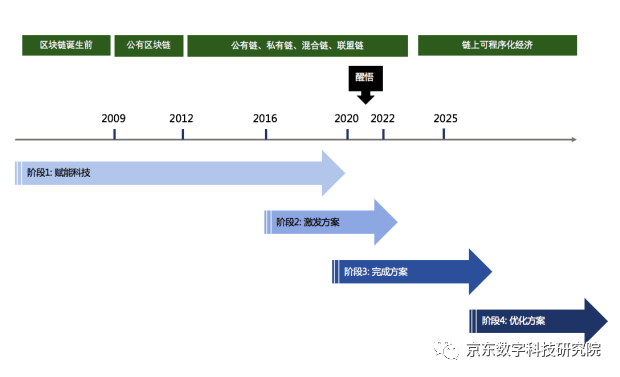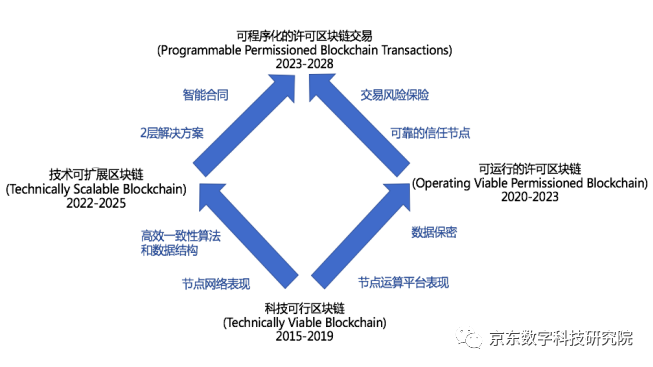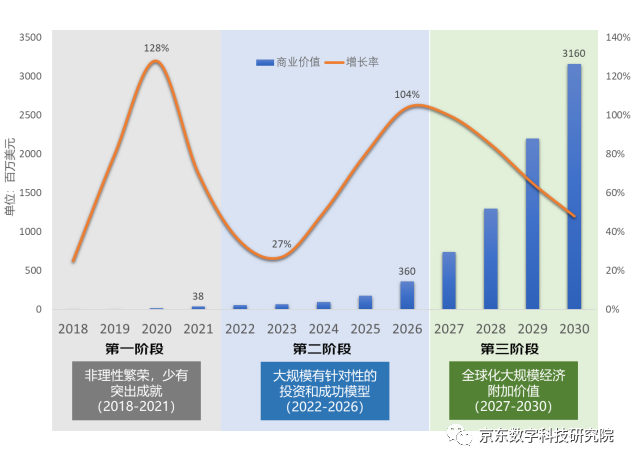Gartner: Blockchain will achieve globalization and scale in 2027
In the severe global economic situation, blockchain has become a hot air outlet in the past two years. Blockchain technology and the socio-economic value industry behind it have gradually attracted more and more attention. The capital market's enthusiasm for blockchain has never stopped, whether it is the birth of "the first share of the global blockchain" or the cleanup and remediation of virtual currencies that distort the nature of the blockchain. Therefore, we hope that through Gartner's research and forecast on the development trend of the blockchain, we will have more thoughts on the key technology research process, application promotion, and business model in the future.
How to define a blockchain
Blockchain has brought a new development paradigm to business. This technology will inevitably change the existing business and social models. The blockchain originated from Bitcoin, and now the blockchain has developed into a collective name for related technologies. These blockchain technologies have brought the possibility of value creation to all industries. The capabilities that blockchain can achieve include: first, digitizing assets; second, providing new ways for value transfer; third, removing central authorization steps or intermediaries in interactions / transactions; fourth, ensuring that record backups are traceable and cannot be changed.
From the operation mode, blockchain can be divided into centralized blockchain, decentralized blockchain and distributed blockchain. Different architectures may have different governance, business models and operational meanings.
Table 1 Classification of blockchain architecture
- EOS founder BM latest article: Refactoring EOSIO resource allocation
- QKL123 market analysis | The trend starts to go bad, is it a good time to make a decision? !! (1127)
- Suddenly! 342,000 ETH transferred to unknown address, South Korean exchange Upbit suspected of being stolen

Source: Gartner, collated by Jingdong Institute of Digital Technology
In fact, the blockchain can be an expandable encrypted list. On the list, all transaction records are irreversible and can be shared by all participants. Each record is time-stamped and linked to a transaction that has occurred before. Anyone with permission can use this information to track any transaction that occurred to any participant at any point in time.
Problems in the application of blockchain technology at this stage
Blockchain technology has been around for almost 10 years, but this cross-generation technology has still not been widely used by most companies in the production management process, mainly in the following aspects:
The first is conceptual misunderstanding. The concept of blockchain is still misunderstood by the market due to its complexity and particularity. Enterprises have misunderstandings about the technology itself, its capabilities, and the possibility of its future. These misunderstandings have caused improper investment.
The second is application misunderstanding. Blockchain technology cannot be applied to the actual business of all enterprises in practical applications. Many companies only apply some of the characteristics of the blockchain, and the true core value of the blockchain: decentralization and tokenization are rarely used .
The third is technical weakness. Blockchain technology is booming and constantly improving, which also means that the current practical application of this technology is not mature. Although pioneering companies are constantly exploring, this technology is still difficult to perfectly meet the needs of the industry.
Fourth, the mind is solidified. Because of its advanced nature, blockchain technology may subvert existing business models. At present, it is difficult for enterprise managers to abandon traditional corporate management ideas and only use blockchain technology to optimize existing processes, which makes it difficult for the technology to break through at the application layer.
Fifth, lack of confidence. Due to the lack of successful cases of blockchain technology in practical industrial applications, entrepreneurs are discouraged by this technology. According to a Gartner survey, in 2018, more than two-thirds of the CIOs participating in the survey were interested in blockchain technology, but only 1% of them actually applied or invested in blockchain technology, of which there were 22 % Only uses blockchain technology as part of the short-term plan, and it is not included in the company's long-term plan.
Third, the development trend prediction of blockchain
At present, the blockchain needs to be further researched and improved in many aspects. Based on Gartner's prediction of blockchain technology, key research forecasts, and business value predictions, we believe that there will be more blockchain innovation projects and solutions in the future. Constantly emerging.
01 Blockchain Technology Forecast: Gartner Spectral Model
According to the blockchain spectrum model built by Gartner, the cross-evolution of blockchain will go through four stages: enabling technology, stimulating solutions, completing solutions, and optimizing solutions (as shown in Figure 1). In the first stage, before the emergence of the blockchain in 2009, around 2020, the blockchain is still in the stage of technological growth and improvement. The second stage is from 2016 to 2022. After the basic formation of the blockchain technology, the blockchain technology has begun to be nested into solutions, but at this stage, the practical application of the blockchain is still being explored. After experiencing the booming development brought about by the technological explosion, the application of the blockchain has gradually encountered a bottleneck, and an epiphany will occur around 2021, and the blockchain will achieve a breakthrough at the application level. The third phase starts around 2020 and ends around 2025. Blockchain-based solutions will gradually take shape. The fourth stage will start from around 2027, and the blockchain solution will be basically completed, gradually enhancing its capabilities and optimizing efficiency.
Figure 1 Gartner spectral model
 Source: Gartner, collated by Jingdong Institute of Digital Technology
Source: Gartner, collated by Jingdong Institute of Digital Technology
According to Gartner's scalable model, the blockchain will encounter 8 difficulties in the future development (as shown in Figure 2). Only by solving these 8 obstacles can the blockchain develop into a programmable permissioned blockchain. Among them, 4 difficulties are technical difficulties to be overcome under the condition of ensuring decentralization; the other 4 difficulties appear in the operation model. Only companies that overcome these 4 difficulties can successfully participate in private chain transactions. According to predictions, these 8 obstacles can be overcome, and the blockchain will be developed into a programmable permissioned blockchain between 2023 and 2028.
Figure 2 Gartner Scalable Model

Source: Gartner, collated by Jingdong Institute of Digital Technology
Blockchain has infinite possibilities and can bring huge business value to enterprises. Through Gartner's prediction of the commercial value of blockchain technology, the commercial value of blockchain from 2018 to 2030 will go through three stages, from irrational prosperity to real globalization. In 2022, only 10% of enterprises will undergo a complete transformation due to blockchain, but at least one business innovation based on blockchain technology has a value of $ 10 billion. In 2026, the commercial value of blockchain will reach $ 360 billion. By 2030, the commercial value of blockchain will exceed $ 3.1 trillion. The growth rate of blockchain commercial value will reach 124% around 2020. After irrational prosperity, the commercial value of blockchain will enter a period of relatively stable growth in 2022. By 2027, blockchain technology Entering a truly mature period, it is expected to achieve globalization and scale.
Figure 3 Business Value Forecast of Blockchain 2018-2030

Source: Gartner, collated by Jingdong Institute of Digital Technology
How to make better use of blockchain
Based on Gartner's predictions, we believe that the future potential of blockchain is huge. Blockchain technology can change or even disrupt the operation mode of enterprises, industries, and even the overall economic environment. Blockchain is considered a natural fit with financial services because of its storage value and reduced fraud. But it has been proven that financial services are not the only industry suitable for blockchain, or even the first industry to apply blockchain technology. CIOs in almost all industries have shown great interest in blockchain technology. Commercial competition pressure means that companies need to find any possible competitive advantage. The correct use of blockchain will become a suitable select. If an enterprise wants to truly use blockchain technology to create value, it needs to fully understand the changes that blockchain's potential has on both technology and business. According to Gartner's report, the potential of the blockchain intersects and influences business and technology (see Figure 4).
Figure 4 Blockchain-based transformation model

Source: Gartner, collated by Jingdong Institute of Digital Technology
Implementing specific strategies, companies need to pay attention to the following three points:
First, corporate CIOs or other decision makers should sort out the concept of blockchain, clarify the characteristics of different types of blockchains, and truly understand the capabilities, application values, and development trends of blockchains.
Second, at the level of scientific and technological research and development, the blockchain is still in the process of research and development, and there are still very few solutions that can be scaled up and applied to business processes. However, due to the high level of attention from all parties, the development of blockchain technology has exploded. If companies want to truly stay at the forefront of the blockchain technology tide and use this technology to establish a competitive advantage for themselves, they should establish independent research and development. The department can research and develop technology and applications according to the actual needs of the enterprise, and cannot wait for it. Expect mature solutions to appear on the market, and then invest in them.
Third, at the business model level, Gartner's research proves that the applicability of blockchain is different and independent in any industry and any business process. This means that even a mature blockchain solution cannot be used to replicate different business processes in different industries, different enterprises, or even the same enterprise. Enterprises need to carry out targeted deployment of how to develop and use blockchains according to specific business processes. plan.
References:
[1] Blockchain-Based Transformation: A Gartner Trend Insight Report
[2] Blockchain Technology Spectrum: A Gartner Theme Insight Report
Source of this article: Jingdong Institute of Digital Technology
Author: Zhang Yue Researcher of Industrial Finance Center of JD Academy Wang Zitao Assistant Researcher of Industrial Finance Center of JD Academy This article represents the author's personal opinion only
We will continue to update Blocking; if you have any questions or suggestions, please contact us!
Was this article helpful?
93 out of 132 found this helpful
Related articles
- Popular science | Ethereum Istanbul upgrade content interpretation
- BTC rebound gradually stabilized, weekly level callback is nearing completion
- Dialogue Lang Xianping: Why did the People's Bank of China propose fiat digital currencies at this time?
- 2019Q3 Blockchain Mining Research Report: Low-power mining machines will gradually establish advantages and the mining industry enters a new era
- Public chain Algorand “opens” with few market communities
- Featured | Consensys: Decentralized Brands Are Key to Mass Adoption
- I'm working on the blockchain this month, and witnessed from the air vent to the "muzzle"






